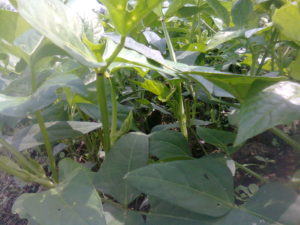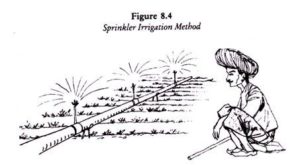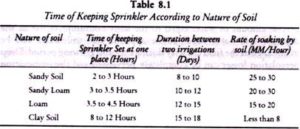In present times, when water crisis is developing very fast everywhere, we should adopt improved techniques of irrigation to encourage suitable water management. Sprinkler irription method is an easy and simple method of irrigation in present times.
The whole land becomes available for cultivation of crops, whereas in traditional irrigation methods, 15 to 20 per cent land remains vacant in depressions and boundaries. Modern equipment’s can also be used in it due to absence of depressions and boundaries. Rate of infiltration is higher in sandy soils where frequency of watering is more. Hence, sprinkler irrigation method is more suited to sandy soils.

In sprinkler irrigation method, water is taken from source to the fields through pipes, whereas in surface irrigation methods only 30-45 per cent water reaches the crops. Such loss of water is avoided in sprinkler irrigation method. The problem of water logging or ‘kallar’ may be caused in case of excess water from surface irrigation, whereas no such problem is caused in sprinkler irrigation method. The balance of groundwater is also maintained.
For development of sprinkler irrigation method, the following circumstances are essential:
1. It is done in areas having scarcity of water.
2. Uneven ground level where irrigation is not possible by other irrigation methods.
3. Places having maximum temperature where crops might get destroyed, sprinkler irrigation method maintains humid environment for the crops.
4 .Where soil textures may be of different nature, for example, sandy soil at some places and stony soil at others places.
5. It requires lesser number of labourers hence, it can be developed even where there are less workers.
6. Irrigation may be required in large areas.
7. There should be average technical knowledge.
In areas where change in temperature of earth, environment and humidity is required for growth of crops, sprinkler irrigation method is possible to a certain extent. Due to continuous spray of water, there IS improvement in physical conditions of earth and composition of soil. In kallar or reh soils, land can be improved by sprinkler irrigation, whereas surface irrigation needs much more water for it.

Thus, it is a suitable irrigation method for sustainable development of water resources in present times. It is installed in fields by three methods:
1. Permanent:
In this method, the main line and branch pipelines are permanently installed in the field. After that it is not possible to shift its place. In this system, labour involved in shifting of lines from time to time is saved but it is quite expensive. The pipeline remains safe being underground, whereas in case it is outside, the breakages are more by frequent changing. Such an arrangement is suitable for canal irrigated areas having ‘barabandi’ where water becomes available for a very limited time.
2. Semi-permanent:
In this method, the main pipeline is permanently fixed under the ground level but branch pipelines are kept outside temporarily so that by changing their places, the whole of the land might be irrigated.
3. Temporary:
In this case, the whole arrangement is temporary and their places can be transferred as per requirement. In this method, more irrigation is possible with lesser investment. It of course needs more labour.
Working System of Sprinkler Irrigation Method:
Due to different surface levels, location of tube wells and size of farm lands are different, hence sprinkler irrigation method has not been considered as a suitable method in all cases.
While fixing sprinkler system on the farm, the following facts should be kept in mind:
1. The main pipeline of the sprinkler system should be fitted in the middle of the farm towards the slope so that balanced irrigation is done on both the sides.
2. Branch pipeline should be fitted across the main line inversely to the slope.
3. Direction of the air should also be kept in view and it should be fitted at 90° of the direction of the air but in no case it should be lesser than 45°.
4. Irrigation of crops need to be done according to time hence, crops requiring water at similar time should be sown near each other, so that extra labour is saved.
5. Even after changing the branch lines, the number of nozzles should remain same.
In sprinkler system, parts needed are pipe, nozzle, risen, coupler, bend, reducer, foot baton and dot etc. While erecting this equipment in the farm, there are two types of expenditure, i.e., initial investment, and expenditure on maintenance of the set.
Initial investment depends on location of the tube well and area of the field. Maintenance is more beneficial in case of tube well as compared to well and an engine. Initial expenditure is 55-60 per cent whereas maintenance expenditure ranges between 40-45 per cent.
The sprinkler set is kept according to the nature of the soil of the farm and on such basis is decided duration between one and the other irrigation. In sandy soil, sprinkler set is kept at one place for 3-4 hours and duration of 8-10 days is kept between the two irrigations.
As per soil, the time of keeping sprinkler at one place and duration between two irrigations should be as under:

Advantages/Pros/Benefits:
1. There is increase in production and compactness.
2. It is helpful in soil conservation and stabilization of sand dunes in desert areas.
3. Sprinkler system is considered more suitable in areas where slit is coagulated on surface of soil after rains, prevents growth of crop.
4. This system saves the crop from extreme frost or temperature.
5. Fertilizer application as well as insecticide spray can be done by sprinkler system.
6. Waste land can be improved by less water. Physical condition and composition of soil can be maintained in a balanced condition by continuous sprinkling.
Disadvantages/Defects/Cons:
1. Sprinkler irrigation method is expensive.
2. It requires technical knowledge.
3. Sprinkler irrigation method cannot be used in all crops.
4. Crop is damaged by changing sprinkler system again and again.
5. Water to be used in sprinkler method should be clean.
In spite of the above defects, sprinkler irrigation method is being adopted with great speed due to increasing water crisis.
